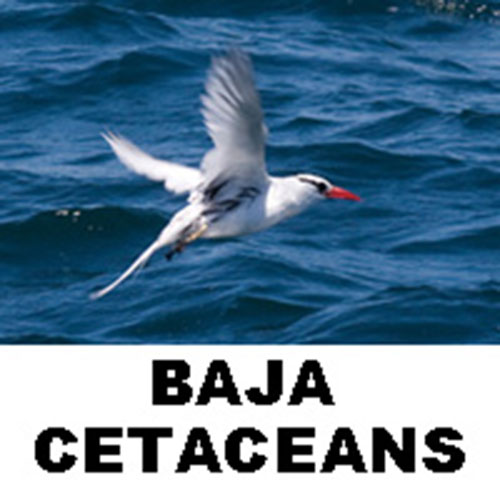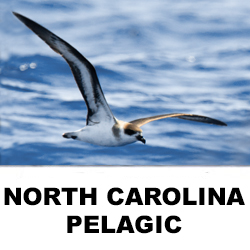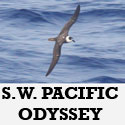|
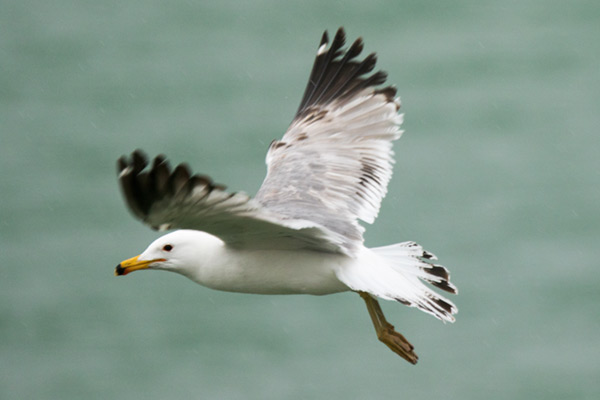 For our next trip Mike and I decided to try Armenia. Reading trip reports it seemed that the country was full of birds, many
difficult to see without visiting large parts of Turkey, although Mike swears I only wanted to photograph Armenian Gull. The
advantage of Armenia is that it is quite small and whilst mainly mountainous does have a number of different habitat types,
including the world-famous Armash fish ponds. What also appealed was that there are very few Armenian birders and there were
opportunities to increase the countries knowledge of distributions etc. We also had a lot of help from Karen Aghababyan, who
seems to be the chief liason with birders from other countries. More of this anon.
For our next trip Mike and I decided to try Armenia. Reading trip reports it seemed that the country was full of birds, many
difficult to see without visiting large parts of Turkey, although Mike swears I only wanted to photograph Armenian Gull. The
advantage of Armenia is that it is quite small and whilst mainly mountainous does have a number of different habitat types,
including the world-famous Armash fish ponds. What also appealed was that there are very few Armenian birders and there were
opportunities to increase the countries knowledge of distributions etc. We also had a lot of help from Karen Aghababyan, who
seems to be the chief liason with birders from other countries. More of this anon.
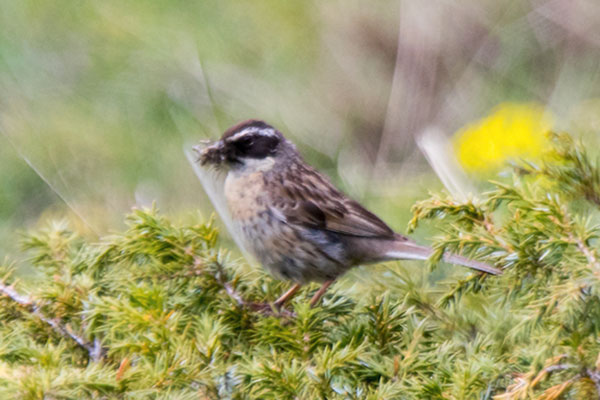 Monday 13th May
Monday 13th May
We arrived early in Yerevan, the capital, due to a flight change, but were pleased to see the Sixt car hire office open.
One of the best car hire experiences I have ever had saw us ready to go in a 4WD Kuga, complete with English speaking Satnav,
in about half an hour. Unfortunately my luggage wasn't, this apparently being a not uncommon problem with flights routing
through Moscow. In retrospect, it would probably have paid us to fly in to Georgia, which would have meant a few new species
and a greater choice of flights. The best way to travel from London is probably with Air France via Paris, but, certainly when
I booked, it was quite a bit more expensive. We hadn't planned anything for our arrival day, but had been told of a site
for Eagle Owl at the Temple of Garni, not far from Yerevan. Going straight from the airport gave us a clue as to what Yerevan
traffic was like, but at least it didn't come as too much of a shock when trying to find our hotel later. Leaving the city we
saw Levant Sparrowhawk and several Black Kites in the air.
Unfortunately when we arrived at Garni the place was overrun with
tourists, so we elected to drive around the area to see what we could find. There were several common species such as Roller, Hoopoe
and Larks, but a bonus came in the shape of a Booted Eagle flying over somewhere we had stopped to buy drinks. However, I mentioned
contributing to the country's knowledge of bird distribution, and
as we came to the end of a lane Mike saw a "little brown job" fly into bushes. We began a search, when I looked up to investigate
a bird singing in the hawthorn bush behind us I saw one of our target species- Radde's Accentor! We had good views of it, but
it was never photographable, although we would surely see more. Speaking to Karen later, they are rarely, if ever, recorded from that
area and as it appeared to be a breeding bird our sighting caused much interest. We had booked two nights in Yerevan, in retrospect
one (or none) would have been enough, because of the appalling driving standards. According to Karen matters have improved, but in our
time there we saw several accidents, including a chap knocked off his motorbike, and many cars with front and rear valences missing.
Had Mike not been a very experienced driver we would surely have ended up with a damaged hire car. You can't drive fast enough to
cause serious injury, which is the only saving grace.
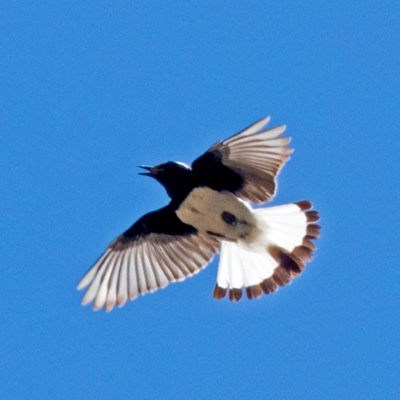 Tuesday 14th May
Tuesday 14th May
Despite the missing luggage, we made for the Vedi Gorges as planned the following morning. Although easily accessed, there is confusion
among tour reports as there are actually two main gorges, plus the birdlife varies dependent on the conditions, especially the
availablity of water. Both gorges should be visited, although because we had to return to Yerevan to buy emergency clothes we only
had time for the westernmost gorge, plans were adjusted to fit the other one in later in the trip. Both areas can be driven into,
but once reaching the gorge itself it is best to get out and walk, which is only to be expected given that most of the birds in the
area are passerines. The gorge we chose had quite a long drive through farmland to access it, and we began to see the common species
of the region, Black-headed Bunting, Crested Lark, Black-eared Wheatear, and not quite so widespread, Rufous Bushchat. The last has a
number of differing names, but use of the old name will be familiar to most British birders (used for the long-ago record from the days when
news was spread by postcard!). At the edge of the gorge itself was a family party of five young Isabelline Wheatears, I photographed them
together on one flat rock. The parents were completely happy with our prescence, just carrying on their normal daily activities, which may
explain why vagrants in the UK are often approachable, since they are familiar with local shepherds and farmers.
As we got further up the gorge the birdlife changed, the Black-eared Wheatears gave way to Finsch's Wheatear, a target on most
people's trip list. Superficially rather similar, we were soon able to pick out Finsch's by their jizz, and probably ended up seeing in
excess of twenty, many being obviously breeding. Other species in the gorge seemed rather thin on the ground, in particular we saw no
Rock Nuthatches nor Grey-necked Buntings, so we determined to fit the eastern gorge in somehow. However, near the beginning, on our return
we saw a small stream which due to the terrain had been hidden on the way up. Birds were coming to the water to drink, Black-headed Bunting,
White Wagtail, Linnet, and Mike had a brief view of a Penduline Tit. A brief visitor to the small flooded area at the lowest part was
rather unexpected, and became bird of the day. Apparently Desert Finch is starting to colonise the area, but sightings are few and far
between at present, so we thought ourselves lucky. Wondering where all the Rock Nuthatches had got to, we left early to buy some clothes.
Thankfully I never had to use those clothes, since Yerevan is a city populated by young people, and Armenians generally don't suffer from
obesity. As a consequence we could only find slim fit clothes, with designer names all over. By buying XXL I could actually get in to them,
but I normally wear my clothes quite loose. At least when the bag arrived Mike was the grateful recipient of four designer T-shirts, which
fitted him a treat! An interesting aside is the cost of such designer clothing, I haggled to buy a pair of genuine Adidas trainers for £18,
on English websites they sell for £75! Who's being ripped off then!
We spent a very pleasant evening with Karen and a few beers, sorting out permits etc. for the rest of the trip, so tight clothing was soon
forgotten. Karen is very interested in any records as observer coverage in Armenia is very thin, obviously making your records available
(and photos in my case) helps conservation work.

 Wednesday 15th May
Wednesday 15th May
We had elected to leave early, the hotel provided a free packed lunch in lieu of breakfast, but the arrival of my case wasn't the only
thing to delay us. Mike had diarrhoea, but I dosed him up and eventually we left about an hour later than intended. Unfortunately that
was enough for the Yerevan dodgems to be well in operation, and Mike wondered whether the cause of his problem might have been the thought
of negotiating our way out again. Thankfully the traffic wasn't slow moving, so we arrived at Armash Fish ponds in about an hour and a half.
Along the way we saw White Storks and several distant raptors, stopping at the roadside was easy although we only stopped once as we were
eager to get to our destination. The Fish ponds cover a huge area, and are home to many species. They are private, but provided permission
is obtained and a small fee paid most of the area is of open access. The main reason for the permit is because they are alongside the border
with Turkey, and passport details are required so the border guards can investigate who's there, if necessary. In practice, the days when it
was dangerous to even look in to Turkey are long gone. Birding can either be done on foot on by car, although a car obviously helps to cover as
much ground as possible. What is on which pond varies, as ponds are drained for their fish periodically, but luckily the area by the track
beyond the gate doesn't seem to be used for fishponds, cattle were being grazed when we were there, much to the concern of the local
Black-winged Stilts.When you pass through the entrance gate it is best to turn left, and after about half a mile you will come to a
rise in the track where another track goes off to the right and back the way you've come. Whilst you could drive it is far better to walk
this track, as about two hundred yards in you are overlooking the main breeding area for White-tailed Lapwing. We had 'scoped them from
the entrance track but this provided much closer views, along with several Glossy Ibis and Little Egrets.
Also around the mound were Blue-cheeked Bee-eaters, obviously a small colony although we couldn't see the nesting area, and our first Menetries's
Warbler sang from a telegraph wire, unfortunately against the light. A Bittern flew over, our only one of the trip.
Having seen these three key species we decided to drive the various tracks and stop where anything looked
interesting. Unfortunately, spring having seemingly come early to Armenia, many of the migrating birds and remnants of wintering gull and
duck flocks had left, but we weren't too bothered, we had deliberately come late because two of our target species are late arriving
migrants. There was still plenty to see, although as the only waders were congregated on a pool looking in to the sun, all we could positively
identify were Ruff and Redshank. Pygmy Cormorants were constantly flying over, as were Black-crowned Night-herons, Red-crested Pochards and White-winged
Terns, with the odd Purple Heron by way of a change. Grey Herons were also around, but outnumbered by the former.
A few immature Armenian Gulls flew about, but the bulk of the gulls seemed to have gone, which was a disappointment for Mike as he'd
hoped for a lingering Pallas', and for me as I still haven't got a decent photo of Slender-billed!
Whilst Armash is a wonderful place, the viewing isn't always great as the reeds mask the water in many places and the ponds are large. This isn't
too much of a problem but birds may be rather distant. You can't have everything! In particular Pygmy Cormorants are far more wary than their
larger cousins, strangely Great Cormorant only occurs at Lake Sevan. Eventually we got good views of Ferruginous and White-headed Ducks, in
breeding garb, both species breed there. Marbled Duck has rarely been seen recently, Mike picked up two in flight, but I can only count them
on my Turkey list. Needless to say we weren't inclined to follow them across the border, but contented ourselves with a view of Eastern
Olivaceous Warbler and Rufous Bushchat on the fence, and Red-backed Shrike in Turkey. Also in the area were more Blue-cheeked Bee-eaters,
joined this time by their European cousins, and a pair of Short-toed Larks.
Unfortunately round about this time Mike started to feel worse, and although he struggled on
for a bit eventually decided he could bird no more. We returned to the mound and he elected to sleep in the car for a couple of hours to see
if that helped (it did). Being a pharmacist I knew he was in no danger provided he kept windows open and drank plenty, so I walked down the
track past the plovers to continue our exploration. The path continued for some distance, revealing further ponds and cultivated areas, but most
of it was lined with tall reeds. Within these reeds could be heard Bearded Reedling, Savi's, Reed, Great Reed, Paddyfield and Moustached Warblers.
I managed to photograph some Bearded Reedlings, but didn't actually see much else. As Mike wasn't with me I didn't try too hard, but
one species I did see well, albeit briefly, was a family party of Moustached Warblers. This of course was the only one that would have been a
tick for him! In gaps in the vegetation I saw most of the ducks, including White-headed, and finally found some roosting gulls and terns. Sadly,
apart from one Baltic Gull, the gulls were all immature Armenian, and the terns all White-winged. Some open ground at the end of the ponds held a
few Short-toed Larks, that was as far as I walked and I eventually returned to Mike, determined to revisit later in the trip.
 Thursday 16th May
Thursday 16th May
Fortunately Mike was much improved when I got back to the car, having slept for much of the time, and by the time we got to our next hotel
was fully functional again (including eating a large dinner!). This particular hotel, near the village of Vayk, is often used by tour groups
as it overlooks a valley, and the surrounding area is quite good for commoner species. We went for a walk before breakfast, but found little
birdlife apart from a Black-eared Wheatear. We concluded this was due to the availability of food, it being unecessary for birds to start
feeding at the crack of dawn. However, things began to liven up after breakfast, when we watched Crag Martins mating on window ledges of
the hotel, and a Blue Rock-thrush singing from the top of a flagpole. (We saw few others in the trip, Rufous-tailed being far commoner). Other
species included Eastern Olivaceous Warbler, Hoopoe, Common Swift, House Martin and Whitethroat.
There are many sites in this area, we elected to first visit Noravank Monastery, which although a tourist attraction has a reputation for being
a good spot for Red-fronted Serin. Rather than walk in we took a path to the left, thus keeping us out of tourist's way, but the place wasn't
exactly heaving with birds. An early morning visit would probably have been more productive, but we saw one of our targets, Eastern Rock Nuthatch,
on rocks opposite the monastery wall, and both Red-billed and Yellow-billed Chough were flying overhead. As we continued walking round we saw
Black-eared Wheatear, which we saw nearly every day of the trip so I shan't mention them again, Crag Martin and Swallows, and eventually,
Red-fronted Serin. However, try as we might we could not get a decent view of the Serins perched, and every time they flew it was a distance away.
We suspect there were several pairs, but as we saw no more than two birds together at any time we can't say for certain. We returned to the wall
where we'd seen the nuthatch, and thought we may have seen a Western, which we'd also suspected on the way up, but couldn't pin it down. The two
are often seen in the same area but need good views to be certain. Eastern is much larger, and as you get more used to them become fairly easy
to sort out.As there didn't seem to be much else around apart from a few butterflies which were photographed to identify later, we walked back
through the monastery grounds, as we left we realised there was a kiosk with an entrance fee, so we went back & paid it (not!). Just below the
site we had seen a small wooded stream so thought we'd explore. We had in fact seen numbers of Common Rosefinch, several adult males included, on the journey
up but hadn't stopped long. This time we walked down the stream for a way, but saw far more butterflies than birds. A Grey Wagtail was in the stream,
rosefinches still around, but it was beginning to get hot so other birds were staying under cover. As Noravank had been our only scheduled site that
day, and we had come with the intention of covering new areas, we wandered towards The Selim Pass, which is to the north and leads eventually to Lake Sevan.
We hadn't been travelling long when we saw an interesting looking meadow with trees, so we stopped for a look. Almost the first birds we saw were
Red-fronted Serins. They still didn't hang around long enough to be photographed, but at least we had good views. Very few other birds were of note, but
a number of butterflies kept up the interest. Painted Ladies were streaming past, obviously migrants, this was to be a feature of the rest of the trip,
even at the top of Mount Aragats. Mike was pleased to see a Queen of Spain Fritillary, a vagrant to Britain, and I was duly asked to photograph it.
Rather than return to the monastery, we decided to drive to the top of the Selim Pass, as at least the road was decent. Near the highest point was
a water pipe (obviously natural spring water or snow melt) and many vehicles stopped to fill water bottles etc. Armenian water is normally safe to
drink, but you never know where animals have grazed, so we didn't join the locals, but water obviously attracts birds, and we recorded Whinchat,
Black-headed and White Wagtails, Meadow Pipit and Red-backed Shrike. We had expected Water Pipit, but our only sighting was a distant bird. Buzzards
were much in evidence, as they were most days, we saw a pair of Long-legged perched on rocks and flying over our heads, whilst Steppe Buzzards
(vulpinus race of Common Buzzard) provided an interesting comparison.
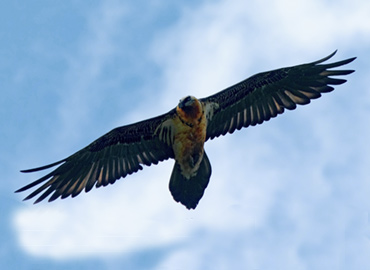
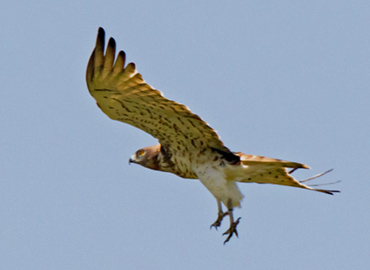 Friday 17th May
Friday 17th May
Our next move was to head south to the Meghri area, which is on the border with Iran. At the time of our trip there was no problem in that area, we could
have spent a day in Iran had we so wished. Our main reason for visiting was that the area is relatively unexplored, and several species occur which
don't further north, but our plans were to change. However, as it's a long journey on pretty terrible roads, with a constant stream of trucks moving in
both directions, we had decided to stop at Goris, birding on the way. Our first stop was completely random, just a likely looking bit of habitat on
both sides of the road, with a convenient layby. We saw a few species, including the ubiquitous Black-headed Buntings, and our first Ortolan. But the star
of the show was an Eastern Orphean Warbler, a tick for Mike. As is common with that species, it proved difficult to get good views, but we did eventually,
when the bird promptly flew up a small valley on the other side of the road. A photo would have to wait, although we walked up the valley a little way
the only new sightings were butterflies, although back near the road we recorded a Rock Bunting on the same bush that had been previously occupied by
an Ortolan..
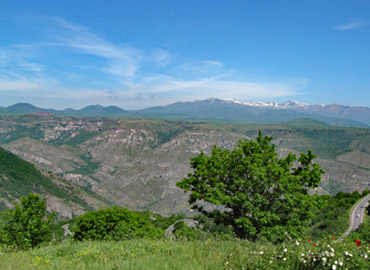 We continued our journey and our next stop was forced upon us by the appearence of an eagle. Mike had his
scope up in record time, the only thing slowing matters down was the automatic opening tailgate on our Kuga, which was far slower than a birder's arm.
Trouble is, if you try to "help" it there's an automatic sensor which tries to shut it again! No problem, the eagle was going nowhere fast, and stopped to
hover. Our identification of Short-toed Eagle was confirmed by our optics, and I managed to get a record shot. A second bird was seen soon after, and
came down to ground level, although it didn't actually land. We continued our journey like this, stopping if we saw a bird or any likely habitat, despite
the condition of the road we arrived at a point overlooking a distant lake and what was obviously Goris about lunch-time. We had pulled off in a large
layby, and decided to have a break, book in to our hotel early and maybe go out again. We looked for birds in the area, Red-backed Shrike,
Black-headed Bunting was about it, and then Mike saw a distant raptor. The scope was already up, and it turned out, after some deliberation because of
the distance, to be our first Golden Eagle of the trip. We decided to stay a bit longer as we had plenty of time, and saw a few buzzards, both Steppe
and Long-legged. Then all hell broke loose, or heaven in Mike's case. A distant Lammergeier, followed by another, and next a Lesser Spotted Eagle. For
the next hour at least there was one raptor after another in the sky, in all directions. As we looked round we realised that the area below us was
surrounded by a ring of mountains, and obviously thermals were common in the area, although a few birds were below us as well. We saw twelve species of
raptor in all, if you include Kestrel. Several birds came quite close, lammergeiers in particular seemed as if they were looking at us as they flew
directly overhead, a total of five in all, two of which were immatures, possibly last years' birds. A Booted Eagle had a good look round, as did a second
Golden Eagle, being "escorted" by two Long-legged Buzzards, of which it took very little notice. At one point things quietened down, and a Eurasian Griffon
flew over high, later followed two by Egyptian Vultures in another direction. We recorded another Short-toed Eagle which was possibly one of the birds we'd seen earlier, as we
hadn't covered a great distance. A distant Greater Spotted Eagle completed the set, we thought, but just as we were starting to think about moving another
Lesser Spotted Eagle flew directly overhead. If this all sounds a bit like a Sheringham seawatch in the eighties (e-mail if you want an explanation), I have
lots of evidence, the only photos missing were the Egyptian Vultures and Greater Spotted Eagle.I must mention that our antics attracted the attention
of a father & son, who obviously lived in a building which looked like a sort of transport cafe. We let them look through the scope and binoculars, in return they
bought out a tray of coffee in elegant, possibly traditional cups, which was excellent. All this without a word of common language between us, showing again
the friendliness of the Armenian people. Possibly our best afternoon's birding of the trip, and not a spot that's been mentioned in any tour reports hitherto.
We still had time before needing to be at our hotel, so we drove just the other side of Goris to the stones at Karahunj. These are a tourist attraction,
they are basically the same idea as Stonehenge, but older, however not as impressive as they cover a larger area and are individually much smaller. Of course,
birds were around and we saw our first Lesser Grey Shrike and our first Northern Wheatear, plus Hoopoe, and a singing Black-headed Bunting which allowed
close approach, but little else of note. On returning to Goris we checked in at Hotel Mina, which while not impressive from the outside, turned out to be one
of the best of our trip. The car was parked right outside, in a wide street which carried little traffic anyway, and our room was directly above it. Not that
there is much crime in Armenia outside the capital, we could have left in unlocked. Our host was a lovely bubbly lady who spoke good English, we paid up-front
and the change (about 2USD) was given in two (very welcome) bottles of beer as her till was short. The big plus with this place was the garden, we were
allowed to wander around and had our breakfast outside. Whilst not very large, there was constant Nightingale song, and we managed to see one bird that evening,
another trip tick. We could see the garden from where we ate our evening meal, and a woodpecker flew in to a trunk, and off again almost straight away. We
saw enough to be 99% certain of its identity as a Syrian, as we saw another later it's a moot point.
We continued our journey and our next stop was forced upon us by the appearence of an eagle. Mike had his
scope up in record time, the only thing slowing matters down was the automatic opening tailgate on our Kuga, which was far slower than a birder's arm.
Trouble is, if you try to "help" it there's an automatic sensor which tries to shut it again! No problem, the eagle was going nowhere fast, and stopped to
hover. Our identification of Short-toed Eagle was confirmed by our optics, and I managed to get a record shot. A second bird was seen soon after, and
came down to ground level, although it didn't actually land. We continued our journey like this, stopping if we saw a bird or any likely habitat, despite
the condition of the road we arrived at a point overlooking a distant lake and what was obviously Goris about lunch-time. We had pulled off in a large
layby, and decided to have a break, book in to our hotel early and maybe go out again. We looked for birds in the area, Red-backed Shrike,
Black-headed Bunting was about it, and then Mike saw a distant raptor. The scope was already up, and it turned out, after some deliberation because of
the distance, to be our first Golden Eagle of the trip. We decided to stay a bit longer as we had plenty of time, and saw a few buzzards, both Steppe
and Long-legged. Then all hell broke loose, or heaven in Mike's case. A distant Lammergeier, followed by another, and next a Lesser Spotted Eagle. For
the next hour at least there was one raptor after another in the sky, in all directions. As we looked round we realised that the area below us was
surrounded by a ring of mountains, and obviously thermals were common in the area, although a few birds were below us as well. We saw twelve species of
raptor in all, if you include Kestrel. Several birds came quite close, lammergeiers in particular seemed as if they were looking at us as they flew
directly overhead, a total of five in all, two of which were immatures, possibly last years' birds. A Booted Eagle had a good look round, as did a second
Golden Eagle, being "escorted" by two Long-legged Buzzards, of which it took very little notice. At one point things quietened down, and a Eurasian Griffon
flew over high, later followed two by Egyptian Vultures in another direction. We recorded another Short-toed Eagle which was possibly one of the birds we'd seen earlier, as we
hadn't covered a great distance. A distant Greater Spotted Eagle completed the set, we thought, but just as we were starting to think about moving another
Lesser Spotted Eagle flew directly overhead. If this all sounds a bit like a Sheringham seawatch in the eighties (e-mail if you want an explanation), I have
lots of evidence, the only photos missing were the Egyptian Vultures and Greater Spotted Eagle.I must mention that our antics attracted the attention
of a father & son, who obviously lived in a building which looked like a sort of transport cafe. We let them look through the scope and binoculars, in return they
bought out a tray of coffee in elegant, possibly traditional cups, which was excellent. All this without a word of common language between us, showing again
the friendliness of the Armenian people. Possibly our best afternoon's birding of the trip, and not a spot that's been mentioned in any tour reports hitherto.
We still had time before needing to be at our hotel, so we drove just the other side of Goris to the stones at Karahunj. These are a tourist attraction,
they are basically the same idea as Stonehenge, but older, however not as impressive as they cover a larger area and are individually much smaller. Of course,
birds were around and we saw our first Lesser Grey Shrike and our first Northern Wheatear, plus Hoopoe, and a singing Black-headed Bunting which allowed
close approach, but little else of note. On returning to Goris we checked in at Hotel Mina, which while not impressive from the outside, turned out to be one
of the best of our trip. The car was parked right outside, in a wide street which carried little traffic anyway, and our room was directly above it. Not that
there is much crime in Armenia outside the capital, we could have left in unlocked. Our host was a lovely bubbly lady who spoke good English, we paid up-front
and the change (about 2USD) was given in two (very welcome) bottles of beer as her till was short. The big plus with this place was the garden, we were
allowed to wander around and had our breakfast outside. Whilst not very large, there was constant Nightingale song, and we managed to see one bird that evening,
another trip tick. We could see the garden from where we ate our evening meal, and a woodpecker flew in to a trunk, and off again almost straight away. We
saw enough to be 99% certain of its identity as a Syrian, as we saw another later it's a moot point.
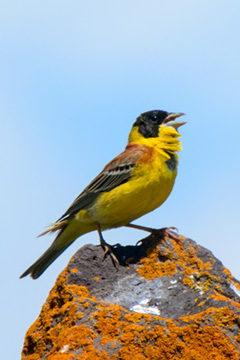 Saturday 18th May
Saturday 18th May
The next morning we had breakfast in the garden, which was strangely quiet. The Nightingales did start up as we were leaving, but we had noticed a lack
of early morning bird activity earlier in the trip, and can only guess that it was the fact that finding food in Armenia is easy, thus allowing an avian
"lie-in". Certainly I photographed more birds with beaks full of insects in a couple of weeks than I ever have previously. Indeed it was difficult to find birds of
some species which weren't obviously breeding. A brightly coloured skink entertained us in the wood pile, but birding was difficult in the garden due to
its being surrounded by similar dense habitat.
We left soon after a delicious breakfast, promising to put a really good review on our booking site, and began the long arduous journey to Meghri. In truth
it's no great distance, but the only main road is in terrible condition and full of lorries. We began by taking a "back route" which meandered in and out of
an Azerbaijani enclave. These enclaves are administered and often populated by Armenians, but remain technically part of Azerbaijan, so I suppose if you're a
country lister (yes they do exist) you can tick it. The main reason we took the route in question was because it went through a number of areas where
we thought we might find several woodland species. We stopped at a likely looking track and walked. Our first discovery was that although there were large
numbers of birds in Armenia, there were also large tracts of undisturbed habitat, so in fact birds were quite thin on the ground. Added to this all the
leaves were out, we could hear lots of song but locating the singers was difficult. Had we been earlier in the year this would have been less of a problem,
but two migrant species might not have arrived. So, we prepared for some hard work. A walk up the track revealed nothing apart from a few common species,
and we turned round to try somewhere else. As we approached the car a Syrian Woodpecker landed on the side of a tree just above it, and I managed to get a
few photos. This turned out to be the only decent view of the trip. Our other forays in to woodland similarly resulted in brief views, so we carried on.
We stopped for a break at another tourist attraction, a caravanserai which had been built on the old Silk Road to China, reputed to be the oldest still
standing. A sort of motel for caravans, it was basically a large room with a hole in the roof, presumably under which a fire was lit, and a long dormitory
off to one side. A Rock Sparrow appeared to be nesting in the roof, and a few other birds were around, but basically it was to stretch our legs and have a break
from driving. As we drove further south the mix of birds changed slightly, but many species were ubiquitous, so we didn't do a lot more stopping and arrived
in Meghri in the early afternoon. Here things began to fall apart. Our booked hotel was nowhere to be found on the satnav, eventually we approached a
policeman who appeared to have little to do except chat with friends. Very few people in this area speak English, but through his phone we managed to make
contact with the hotel, who said they would come and guide us. A battered Lada duly appeared, and I sat in the back whilst Mike followed in our hire car.
There was no sign on the entrance track, and we began to have misgivings. It turned out the place was only half built, not just in terms of a floor to be added
(which is a tax dodge) but literally. Fixtures and fittings were laid on the floor, tape was still on door surrounds and window frames, and our room had none
of the facilities advertised. We decided to put up with it until discovering a smell emanating from a drain plug in the shower room, when we
returned from birding locally. We then decided to cancel
the remainder of our booking. We had arranged to meet a ranger from the local reserve to be taken up the mountain to view Caspian Snowcock, arranged by
Karen, when he arrived and Karen told us that due to the snowline this year there was a considerable walk, we decided to cut our losses and make our way
back north, as we had still to re-visit Armash and the other Vedi Gorge.

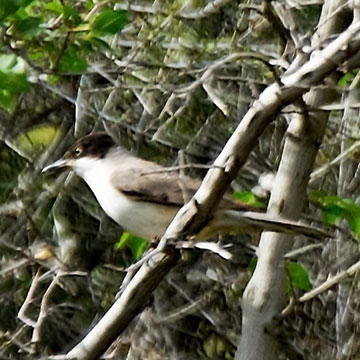
 However, all this happened after our visit to another gorge, apparently a good site for Kurdish Wheatear which is the main reason most birders visit these
remote parts. We found the site easily enough from co-ordinates given by another report. Despite earlier reports the birds apparently occur in several
gorges in the area, and the current situation is that far more sites are known, including one further north (although I could find no details). As we parked
the car, indeed before we had got out, a female Kurdish Wheatear was flying around some farm buildings, giving good views. We decided to walk up the gorge
in the hope of finding a male. This was achieved by Mike, but after perching briefly on a wall it disappeared before I could get on it, and the only view I
got was of the bird flying off. There were signs of habitation, including one obvious house and growing area, but also several disused or derelict buildings.
We didn't spend too long there but resolved to return the next morning, having seen at least three Kurdish Wheatears and several of the ubiquitous
Black-eared Wheatears.
Sunday 19th May
However, all this happened after our visit to another gorge, apparently a good site for Kurdish Wheatear which is the main reason most birders visit these
remote parts. We found the site easily enough from co-ordinates given by another report. Despite earlier reports the birds apparently occur in several
gorges in the area, and the current situation is that far more sites are known, including one further north (although I could find no details). As we parked
the car, indeed before we had got out, a female Kurdish Wheatear was flying around some farm buildings, giving good views. We decided to walk up the gorge
in the hope of finding a male. This was achieved by Mike, but after perching briefly on a wall it disappeared before I could get on it, and the only view I
got was of the bird flying off. There were signs of habitation, including one obvious house and growing area, but also several disused or derelict buildings.
We didn't spend too long there but resolved to return the next morning, having seen at least three Kurdish Wheatears and several of the ubiquitous
Black-eared Wheatears.
Sunday 19th May
After, surprisingly, a reasonable night's sleep and breakfast, we headed back to the gorge, but this time walked further up. The
wheatears were again present, but still little sign of the male, however at least two pairs of Menetrie's Warblers were flying around, obviously intending
to breed. A pair of Eastern Orphean Warblers were exhibiting the same behaviour, but much more slowly and stealthily, although still able to disappear when a camera is
pointed at them! I did manage a few record shots, which is more than I have in the past. Other birds in the gorge included Upcher's and Eastern Olivaceous
Warblers, and Woodchat, but we left in the late morning as it was getting hot, bird activity was lessening, and we had to get back at least as far as Arpi if we were
to fit in a return visit to the Vedi gorges.
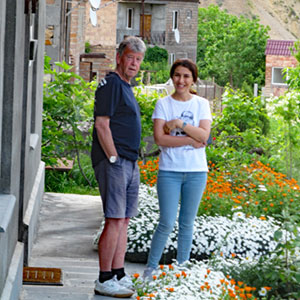
 Taking the route back along the main road, we didn't have a lot of time for stops, but it seemed we hadn't quite missed all the migration, as we stopped
for a total of four Honey Buzzards, the first we had seen this trip. Short-toed Eagle again entertained us, this time seemingly coming to investigate us
as well, so low that I only just got both wingtips in the camera frame. Perhaps it thought the camera lens was a very fat snake! We eventually arrived at
Arpi to find it was in the middle of a wine-growing area which attracted numbers of tourists. We couldn't find the address for the guest house in our
satnav, so we enquired in a large wine tasting (and selling) establishment. They knew the owner of the guest house and within minutes we had a very pleasant
young lady in our car directing us to the place. It turned out to be a very modern building with a large shared lounge and kitchen, and only two rooms! This
was actually a great arrangement, and a lady came in to serve an evening meal and breakfast, together with the owner to make sure everything was OK each
morning, a very personal service. (No, Mike, not that personal, we met her husband, plus she's half your age!). We had originally only booked one night, so
effectively arrived two days early. No problem the first night, but the place was fully booked for the next. This, of course, is merely a slight inconvenience
to an Armenian, so before we went off birding in the morning we were shown to a house where we were to spend the "middle" night. The owner of the house did
not run it as a guest house, but it was on the Airbnb website, and as he had no guests that night we were welcomed with open arms. And what a welcome, a superb meal,
accompanied by a carafe of wine, good conversation and when we went to pay the bill, I actually bartered him up! With regard to the wine, it seems to be
privately produced in a number of small vineyards in people's back gardens. Mostly we were offered red, which I don't normally drink, but I really enjoyed
this, and it's done nothing to alter my opinion of "wine snobbery". Added to which the carafe in Marc's establishment was free! No hangover, always a sign
of quality, so the next morning saw us making for the Vedi Hills once again, but with a much shorter journey.
Taking the route back along the main road, we didn't have a lot of time for stops, but it seemed we hadn't quite missed all the migration, as we stopped
for a total of four Honey Buzzards, the first we had seen this trip. Short-toed Eagle again entertained us, this time seemingly coming to investigate us
as well, so low that I only just got both wingtips in the camera frame. Perhaps it thought the camera lens was a very fat snake! We eventually arrived at
Arpi to find it was in the middle of a wine-growing area which attracted numbers of tourists. We couldn't find the address for the guest house in our
satnav, so we enquired in a large wine tasting (and selling) establishment. They knew the owner of the guest house and within minutes we had a very pleasant
young lady in our car directing us to the place. It turned out to be a very modern building with a large shared lounge and kitchen, and only two rooms! This
was actually a great arrangement, and a lady came in to serve an evening meal and breakfast, together with the owner to make sure everything was OK each
morning, a very personal service. (No, Mike, not that personal, we met her husband, plus she's half your age!). We had originally only booked one night, so
effectively arrived two days early. No problem the first night, but the place was fully booked for the next. This, of course, is merely a slight inconvenience
to an Armenian, so before we went off birding in the morning we were shown to a house where we were to spend the "middle" night. The owner of the house did
not run it as a guest house, but it was on the Airbnb website, and as he had no guests that night we were welcomed with open arms. And what a welcome, a superb meal,
accompanied by a carafe of wine, good conversation and when we went to pay the bill, I actually bartered him up! With regard to the wine, it seems to be
privately produced in a number of small vineyards in people's back gardens. Mostly we were offered red, which I don't normally drink, but I really enjoyed
this, and it's done nothing to alter my opinion of "wine snobbery". Added to which the carafe in Marc's establishment was free! No hangover, always a sign
of quality, so the next morning saw us making for the Vedi Hills once again, but with a much shorter journey.
Monday 20th May
 This time we investigated the Eastern gorge first, which seemed much more attractive to birds. Before we entered the gorge itself we had stopped several
times, although nothing was new except our first Rose-coloured Starlings of the trip, despite Mike trying to talk them up we hadn't connected with any
apart from a distant flock at Vayk, too far to be positively identified. We spent most of the day in this gorge, although we went to investigate the stream
in the other before leaving. Finsch's, Isabelline and Black-eared Wheatears were much in evidence in both gorges, but many more species overall were in the
Eastern gorge, not surprisingly as it had a far better stream meandering through it. However it is really essential to visit both gorges, since conditions
change from one year to the next. A small Roller colony was at the entrance to the gorge in a sandstone cliff, and we soon had better views of Eastern Rock
Nuthatches, as well as a Blue Rock-thrush which was carrying food. As we continued the area flattened out to a sort of wide valley, and birds came thick and fast. Unexpected was at least three pairs of Little
Ringed Plover along the stream, whilst we eventually managed a brief view of a Grey-necked Bunting. The gorges are well known for them, but the numbers
vary, and this year that was our only sighting. Other species included Spotted Flycatcher, Upcher's Warbler on a nest, our first Greenfinch(!) Eastern
Olivaceous Warbler, Cuckoo, Bee-eater and both Buzzards. As we continued we came across a Tawny Pipit, probably a late migrant, and our first White-throated
Robin. One of our targets, we weren't expecting to see them until we investigated Mount Aragats, but they are seen elsewhere in the country in smaller numbers.
This bird seemed to be associating with a Red-backed Shrike, and we at first thought it was being chased, but as we saw similar behaviour later in the trip we
concluded that the robin was picking up insects disturbed by the shrike when it in turn was hunting.Returning back down the gorge, after giving up
trying to get a photo of the robin, since it was flying quite long distances, we came across another bird we had been hoping to see in the shape of a Pale
Rockfinch. Known by various names depending on your field guide (Hill Sparrow, Pale rock Sparrow), these birds are late migrants arriving to breed in
Armenia, and they weren't exhibiting any breeding behaviour, just coming to drink. We walked back along the opposite side, and came across a family party of
Rock Nuthatches, of the Western species this time. When seen together or not far apart in time terms, they are easy to distinguish, Western has the jizz of
a Common Nuthatch, whereas Eastern is much larger and generally more upright, quite apart from the diagnostic black eyestripe continuing round the nape. We
felt we had done justice to the Eastern Gorge, so we visited the Western one again for an hour or so. This was always going to be an anticlimax, and the
hoped-for Desert Finch didn't re-appear, but it was still good birding, with the feeling something new might turn up right up until we left. We were very
glad we returned, as the whole area is quite large, and the variation in species from one spot to another is quite marked. Strangely, birds that others have
seen, such as Menetries's Warbler, we didn't connect with, but saw plenty elsewhere anyway.
We had arranged another trip to see the Snowcock the next day, at a place where little walking would be involved, but that evening we received a phone call
to say the track would not be passable due to the thunderstorm and heavy rain that was currently over the area. Having had an excellent meal and wine once
again we weren't too put out, and although we were offered another day decided that we still had too many places to visit and the Snowcock would have to wait
for another trip. I've seen two species of Snowcock and Mike regards them as "big chickens", so neither of us lost any sleep over it (nor the thunder, think
the wine helped!).
This time we investigated the Eastern gorge first, which seemed much more attractive to birds. Before we entered the gorge itself we had stopped several
times, although nothing was new except our first Rose-coloured Starlings of the trip, despite Mike trying to talk them up we hadn't connected with any
apart from a distant flock at Vayk, too far to be positively identified. We spent most of the day in this gorge, although we went to investigate the stream
in the other before leaving. Finsch's, Isabelline and Black-eared Wheatears were much in evidence in both gorges, but many more species overall were in the
Eastern gorge, not surprisingly as it had a far better stream meandering through it. However it is really essential to visit both gorges, since conditions
change from one year to the next. A small Roller colony was at the entrance to the gorge in a sandstone cliff, and we soon had better views of Eastern Rock
Nuthatches, as well as a Blue Rock-thrush which was carrying food. As we continued the area flattened out to a sort of wide valley, and birds came thick and fast. Unexpected was at least three pairs of Little
Ringed Plover along the stream, whilst we eventually managed a brief view of a Grey-necked Bunting. The gorges are well known for them, but the numbers
vary, and this year that was our only sighting. Other species included Spotted Flycatcher, Upcher's Warbler on a nest, our first Greenfinch(!) Eastern
Olivaceous Warbler, Cuckoo, Bee-eater and both Buzzards. As we continued we came across a Tawny Pipit, probably a late migrant, and our first White-throated
Robin. One of our targets, we weren't expecting to see them until we investigated Mount Aragats, but they are seen elsewhere in the country in smaller numbers.
This bird seemed to be associating with a Red-backed Shrike, and we at first thought it was being chased, but as we saw similar behaviour later in the trip we
concluded that the robin was picking up insects disturbed by the shrike when it in turn was hunting.Returning back down the gorge, after giving up
trying to get a photo of the robin, since it was flying quite long distances, we came across another bird we had been hoping to see in the shape of a Pale
Rockfinch. Known by various names depending on your field guide (Hill Sparrow, Pale rock Sparrow), these birds are late migrants arriving to breed in
Armenia, and they weren't exhibiting any breeding behaviour, just coming to drink. We walked back along the opposite side, and came across a family party of
Rock Nuthatches, of the Western species this time. When seen together or not far apart in time terms, they are easy to distinguish, Western has the jizz of
a Common Nuthatch, whereas Eastern is much larger and generally more upright, quite apart from the diagnostic black eyestripe continuing round the nape. We
felt we had done justice to the Eastern Gorge, so we visited the Western one again for an hour or so. This was always going to be an anticlimax, and the
hoped-for Desert Finch didn't re-appear, but it was still good birding, with the feeling something new might turn up right up until we left. We were very
glad we returned, as the whole area is quite large, and the variation in species from one spot to another is quite marked. Strangely, birds that others have
seen, such as Menetries's Warbler, we didn't connect with, but saw plenty elsewhere anyway.
We had arranged another trip to see the Snowcock the next day, at a place where little walking would be involved, but that evening we received a phone call
to say the track would not be passable due to the thunderstorm and heavy rain that was currently over the area. Having had an excellent meal and wine once
again we weren't too put out, and although we were offered another day decided that we still had too many places to visit and the Snowcock would have to wait
for another trip. I've seen two species of Snowcock and Mike regards them as "big chickens", so neither of us lost any sleep over it (nor the thunder, think
the wine helped!).
Tuesday 21st May
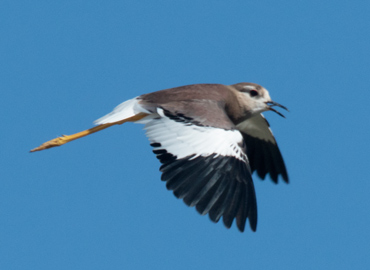 The following morning all signs of clouds had gone, so we made a leisurely start to Armash, which was again a much shorter and easier
journey than it would have been from Yerevan. I phoned Karen and speedily arranged
another permit for Armash Fishponds, which weren't far away but in the opposite diection to Vedi. On arrival we took the same turn as before, but this time
there were many more waders on at least two of the ponds. The commonest species by far was Wood Sandpiper, of which we estimated several hundred, but we also
managed to find Little and Temminck's Stints, and two Terek Sandpipers. More familiar species (to us) were Black-tailed Godwits, Curlew Sandpipers, Common
Sands, and a solitary Turnstone. A flock of Ringed Plovers was obviously a late migration, since none had been present on our previous visit.
Just as we were about to continue a Gull-billed Tern flew past, but we didn't see it again. So we then proceeded
to drive round the area, largely on the same bunds as before, and enjoyed better views of many species, especially both Bee-eaters and White-winged Terns.
At our furthest point, again near the Turkish border, we were watching Blue-cheeked Bee-eaters when I "diverted" briefly to photograph a couple of larks.
Neither of us took a lot of notice, but put them down as Short-toed. Only when I processed my photos did I realise they were Lesser Short-toed. A trip
tick gratefully received, but had they been Bimacs I'm sure we wouldn't have overlooked them in the first place! We never did catch up with Bimaculated
Larks, despite much searching of lark-friendly fields.As Mike was now fully recovered we decided to walk the track I had taken on Wednesday
which passed through the reedbeds. After a long time watching White-tailed Plovers, which Mike had not really been in the mood to watch last time, we
continued to the accompaniment of reed-dwelling warblers which this time were more visible, interspersed with the odd Pygmy Cormorant and Purple Heron being
flushed at our approach, as they were unseen until taking flight. Eventually, although I didn't manage much photography (except of course Reed Warbler) we
had good views of Moustached and Paddyfield Warblers, and saw Great Reed briefly on a couple of occasions. The only species we didn't manage to see was Savi's
Warbler, although we heard a couple. As much as anything the pleasure was in the searching, the reeds were alive with birds which only showed for brief
periods at a time, but the whole area was full of activity and song. At intervals ponds were visible through the reeds, and we had better views of White-headed
Ducks among others. Eventually we decided there was little more to be seen, and after a last look at the White-headed Plovers we headed back to Arpi.
The following morning all signs of clouds had gone, so we made a leisurely start to Armash, which was again a much shorter and easier
journey than it would have been from Yerevan. I phoned Karen and speedily arranged
another permit for Armash Fishponds, which weren't far away but in the opposite diection to Vedi. On arrival we took the same turn as before, but this time
there were many more waders on at least two of the ponds. The commonest species by far was Wood Sandpiper, of which we estimated several hundred, but we also
managed to find Little and Temminck's Stints, and two Terek Sandpipers. More familiar species (to us) were Black-tailed Godwits, Curlew Sandpipers, Common
Sands, and a solitary Turnstone. A flock of Ringed Plovers was obviously a late migration, since none had been present on our previous visit.
Just as we were about to continue a Gull-billed Tern flew past, but we didn't see it again. So we then proceeded
to drive round the area, largely on the same bunds as before, and enjoyed better views of many species, especially both Bee-eaters and White-winged Terns.
At our furthest point, again near the Turkish border, we were watching Blue-cheeked Bee-eaters when I "diverted" briefly to photograph a couple of larks.
Neither of us took a lot of notice, but put them down as Short-toed. Only when I processed my photos did I realise they were Lesser Short-toed. A trip
tick gratefully received, but had they been Bimacs I'm sure we wouldn't have overlooked them in the first place! We never did catch up with Bimaculated
Larks, despite much searching of lark-friendly fields.As Mike was now fully recovered we decided to walk the track I had taken on Wednesday
which passed through the reedbeds. After a long time watching White-tailed Plovers, which Mike had not really been in the mood to watch last time, we
continued to the accompaniment of reed-dwelling warblers which this time were more visible, interspersed with the odd Pygmy Cormorant and Purple Heron being
flushed at our approach, as they were unseen until taking flight. Eventually, although I didn't manage much photography (except of course Reed Warbler) we
had good views of Moustached and Paddyfield Warblers, and saw Great Reed briefly on a couple of occasions. The only species we didn't manage to see was Savi's
Warbler, although we heard a couple. As much as anything the pleasure was in the searching, the reeds were alive with birds which only showed for brief
periods at a time, but the whole area was full of activity and song. At intervals ponds were visible through the reeds, and we had better views of White-headed
Ducks among others. Eventually we decided there was little more to be seen, and after a last look at the White-headed Plovers we headed back to Arpi.
Wednesday 22nd May

 The next day we settled up with our lovely host and continued on our journey, this time to the shores of Lake Sevan. This involved driving over the Selim
Pass once again, but as it happens to be possibly the best road in Armenia (probably built by Carlsberg!) this was no hardship. There seemed to be more
birds around than on our previous journey over the pass, added to which we arrived on the shore of Lake Sevan quite some distance from our hotel, so the
whole day consisted of stopping when we saw something or at any likely habitat. This proved to be a good strategy, and we added several species to the list,
although some were a bit mundane, such as our only Woodpigeons and Moorhens. Our first good siting we unfortunately made a bit of a hash of, thinking we
would see more. This was a Levant Sparrowhawk, on a nest at the side of the road. Unfortunately it was right on a bend with no roadside verges nearby, so
we elected not to walk back, a decision we later regreted. Our first stop was for a (Rufous-tailed) Rock Thrush, which was the second that day, but we
hadn't seen them previously and were beginning to worry as we'd been to places they'd been seen before. It turned out that a breeding pair were there, and
a short walk gave us good views of both male and female, along with Ortolan and Black-headed Bunting. As we drove over the Selim pass it seemed that
most of the same species were there as on our previous visit, but this time our search for Water Pipit proved fruitless. However at one stop we did have
a brief view of a White-winged Snowfinch, one of two, the other kept flying. Attempts to photograph it were thwarted since it had disappeared by the time
we got on to the plateau.
bit further along, past where we had turned round a week ago, we saw a large body of water, with what appeared to be an abandoned village on its shore.
We scoped it, but it seems it was mainly used as a wintering area, since only a few ducks were present. A pair of Ruddy Shelduck flew off, and a pair of
Garganey were new, but there was little else of interest, so we didn't try to get closer. Our first extended stop was just outside a village just before
the road joins with that running alongside Lake Sevan. Here we saw a likely looking area where a bridge ran over a stream, with meadow and a small tract
of forest behind. The first birds to catch our eye were two Armenian Gulls, the first adults we had seen, sitting on a pipe across the stream. We then saw
several warblers which we first took to be Green, but further investigation showed them to be Mountain Chiffchaffs. Lake Sevan is quite high, so they could
have been breeders or migrants. Across the stream was a flash of yellow, we had seen Golden Oriole briefly in flight earlier but this was a group of breeders,
we eventually had good views of males and females, even a few photos. We spent some times with them, listening to their song, although being around lunch
time it was only brief snatches.To our left was a woodland, so we headed in hoping for several woodland species. Unfortunately it was rather quiet but
our search yielded a Tree Pipit, our only one of the trip. The only other species of note were Great Spotted Woodpeckers, of which we had six or seven sightings.
We found this strange, since many of the trip reports we read stated Syrian was common and Great-spots rare. Perhaps this was an isolated population or "no
sign of the Syrian Woodpecker but Great-spots there". (with apologies to non-pager owners for the "in joke"). There were plenty of birds calling, but
not visible, we decided it was the wrong time of day so we continued, at least the orioles had put on a show for us. We soon came to the southern shore of
Lake Sevan, much of it is right next to the road with no shoreline, but a number of spots afford good birding, and stopping is quite easy. One place had fields
and a small swampy area between lake and road, it was here we saw our first Great Cormorant, Pygmy Cormorant doesn't occur here. As we scanned the field in
front of us we realised it contained tens, if not hundreds, of Scarlet Rosefinches, which took it in turns to fly up to the trees behind us. A couple
of Cattle Egrets were new. This was somewhat surprising as there were plenty of ungulates and lots of habitat in the country as whole, but the same paucity
applied to Great White, whereas Little Egrets were widespread. Although we looked in several spots for Citrine Wagtail and Red-necked Grebe we weren't to
be lucky, more time would probably have yielded both.Late afternoon saw us checking (eventually) in to our motel due to the satnav being out of date.
This was described as "rustic" and looked a bit like a ranchouse as we approached, with real wooden doors and stone flags in the courtyard. Obviously it was
partly false, the restaurant was modern inside as were the rooms, but it made a change from the usual standard appearence of most places.
The next day we settled up with our lovely host and continued on our journey, this time to the shores of Lake Sevan. This involved driving over the Selim
Pass once again, but as it happens to be possibly the best road in Armenia (probably built by Carlsberg!) this was no hardship. There seemed to be more
birds around than on our previous journey over the pass, added to which we arrived on the shore of Lake Sevan quite some distance from our hotel, so the
whole day consisted of stopping when we saw something or at any likely habitat. This proved to be a good strategy, and we added several species to the list,
although some were a bit mundane, such as our only Woodpigeons and Moorhens. Our first good siting we unfortunately made a bit of a hash of, thinking we
would see more. This was a Levant Sparrowhawk, on a nest at the side of the road. Unfortunately it was right on a bend with no roadside verges nearby, so
we elected not to walk back, a decision we later regreted. Our first stop was for a (Rufous-tailed) Rock Thrush, which was the second that day, but we
hadn't seen them previously and were beginning to worry as we'd been to places they'd been seen before. It turned out that a breeding pair were there, and
a short walk gave us good views of both male and female, along with Ortolan and Black-headed Bunting. As we drove over the Selim pass it seemed that
most of the same species were there as on our previous visit, but this time our search for Water Pipit proved fruitless. However at one stop we did have
a brief view of a White-winged Snowfinch, one of two, the other kept flying. Attempts to photograph it were thwarted since it had disappeared by the time
we got on to the plateau.
bit further along, past where we had turned round a week ago, we saw a large body of water, with what appeared to be an abandoned village on its shore.
We scoped it, but it seems it was mainly used as a wintering area, since only a few ducks were present. A pair of Ruddy Shelduck flew off, and a pair of
Garganey were new, but there was little else of interest, so we didn't try to get closer. Our first extended stop was just outside a village just before
the road joins with that running alongside Lake Sevan. Here we saw a likely looking area where a bridge ran over a stream, with meadow and a small tract
of forest behind. The first birds to catch our eye were two Armenian Gulls, the first adults we had seen, sitting on a pipe across the stream. We then saw
several warblers which we first took to be Green, but further investigation showed them to be Mountain Chiffchaffs. Lake Sevan is quite high, so they could
have been breeders or migrants. Across the stream was a flash of yellow, we had seen Golden Oriole briefly in flight earlier but this was a group of breeders,
we eventually had good views of males and females, even a few photos. We spent some times with them, listening to their song, although being around lunch
time it was only brief snatches.To our left was a woodland, so we headed in hoping for several woodland species. Unfortunately it was rather quiet but
our search yielded a Tree Pipit, our only one of the trip. The only other species of note were Great Spotted Woodpeckers, of which we had six or seven sightings.
We found this strange, since many of the trip reports we read stated Syrian was common and Great-spots rare. Perhaps this was an isolated population or "no
sign of the Syrian Woodpecker but Great-spots there". (with apologies to non-pager owners for the "in joke"). There were plenty of birds calling, but
not visible, we decided it was the wrong time of day so we continued, at least the orioles had put on a show for us. We soon came to the southern shore of
Lake Sevan, much of it is right next to the road with no shoreline, but a number of spots afford good birding, and stopping is quite easy. One place had fields
and a small swampy area between lake and road, it was here we saw our first Great Cormorant, Pygmy Cormorant doesn't occur here. As we scanned the field in
front of us we realised it contained tens, if not hundreds, of Scarlet Rosefinches, which took it in turns to fly up to the trees behind us. A couple
of Cattle Egrets were new. This was somewhat surprising as there were plenty of ungulates and lots of habitat in the country as whole, but the same paucity
applied to Great White, whereas Little Egrets were widespread. Although we looked in several spots for Citrine Wagtail and Red-necked Grebe we weren't to
be lucky, more time would probably have yielded both.Late afternoon saw us checking (eventually) in to our motel due to the satnav being out of date.
This was described as "rustic" and looked a bit like a ranchouse as we approached, with real wooden doors and stone flags in the courtyard. Obviously it was
partly false, the restaurant was modern inside as were the rooms, but it made a change from the usual standard appearence of most places.
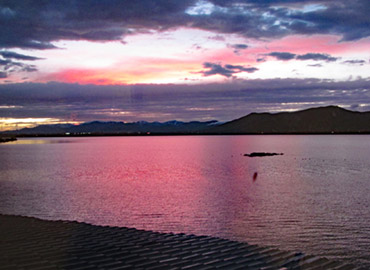 Lake Sevan is known for the world's largest colony of Armenian Gulls, but rather than one huge colony birds breed on numerous small islands throughout the
large area of over 50 square miles. Fortune was obviously smiling on us, for one such island was in front of the large hotel window, right on the edge of
the shore. We were able to study varying ages, although strangely no juveniles were present, maybe it was too early. Also in front of the window were Great-crested
and Black-necked Grebes, resplendent in summer plumage. We found a Night-heron in the reeds, and another trip tick in the shape of a Moorhen! Strange we
hadn't seen them elsewhere as Coots had been numerous, and were here.
Lake Sevan is known for the world's largest colony of Armenian Gulls, but rather than one huge colony birds breed on numerous small islands throughout the
large area of over 50 square miles. Fortune was obviously smiling on us, for one such island was in front of the large hotel window, right on the edge of
the shore. We were able to study varying ages, although strangely no juveniles were present, maybe it was too early. Also in front of the window were Great-crested
and Black-necked Grebes, resplendent in summer plumage. We found a Night-heron in the reeds, and another trip tick in the shape of a Moorhen! Strange we
hadn't seen them elsewhere as Coots had been numerous, and were here.
Thursday 23rd May
 We awoke fairly early, hoping for some migration across the lake. There was little movement except Great Cormorants, so after a while we wandered outside
This was fairly quiet also, although we did have very close views of an adult Armenian Gull and our first Black Redstart, a male of the race ochrurus
which has orange underparts. Returning to our room it seemed that someone had thrown bread on the sloping roof outside our window, and it was covered in
Armenian Gulls. Good job we didn't leave the window open! As we entered they flew and were milling around, too close to photograph, although I did
manage some flight shots later. Mike and I both honed in on a bird on the lake edge, which seemed darker than those around. It was still a bit dark for a
decent photo, but I suspect it may have been barabensis which has a similar bill pattern, and breeds further east.As it seemed we weren't going
to see a great deal else we had a last look for Red-necked Grebe and Citrine Wagtail, with a 100% failure rate, and drove towards our next habitat, which
was the wooded areas around Dilijan. We didn't see much en route, apart from a few raptors, Honey Buzzard, Steppe and Long-legged Buzzards, Lesser Spotted Eagle
and Black Kite, but the journey wasn't far, and we arrived about lunch-time. The wooded area is large and largely undeveloped apart from a few small towns
and hotels, and the odd farm. This vast amount of habitat made things difficult to find, not least of which was our hotel, which was described as an eco-
resort. Here the best thing was the location, we upgraded our rooms when we saw how far away the toilets were, as we were almost the only guests that was
no problem. We had booked single rooms as all the doubles had only double beds, but we had booked that way initially.The hotel was situated near a
small river, and in wandering around the grounds and just across the road we added Dipper and Kingfisher to our list. Around the accomodation area were
several pairs of samamisicusCommon Redstarts, but they were the only birds that showed almost constantly. A short riverside walk in the hotel grounds
produced Blackcaps, our first Coal Tits and Long-tailed Tits of a white-headed race major We soon left the hotel to explore the surrounding areas,
but birding proved very difficult, primarily because the trees were in full leaf. We drove the Parz Lich Road, where most of our sightings were, but penetrating
the forest proved difficult. However, one area had a sort of trail which ran upwards, and we spent quite some time there. In truth, our main target in the
area, Semi-collared Flycatcher, was proving very difficult, although we did have brief views. Following the trail was a bit of a struggle as it was more of
an overgrown firebreak than anything, and we were only able to penetrate about 100 metres in. I was a bit behind Mike when he suddenly called me. I ran up
to him just in time to see a Black Woodpecker disappear behind a tree. This was a tick for me, and Mike had never had good views, so we were well chuffed.
All the more so as previous trip reports rarely record the species. We suspected a second bird in the area as the largely obscured bird moved around, but
eventually it flew to a distant tree giving us good views, enough to determine it was a male. We didn't seem to be making a lot of progress with smaller
passerines, so we returned to a clearing not far from the road and waited in hope. We had a nice view of a Hawfinch, but not much else until a woodpecker
landed on a tree about 50 metres away. Of course, it promptly went round the back, but soon emerged and flew to another tree, right beside where our
car was parked! It was easily identified as a Middle-spotted Woodpecker, and its behaviour indicated a nest hole in the tree. Soon after that we explored
the road a bit more, stopping where we could, but the only bird of note was a Nuthatch, our third species of same. We returned to the hotel and investigated
a track leading up behind the hotel, where we finally saw our only Red-breasted Flycatcher, and further brief views of Semi-collared. A really bright
Green Warbler showed well, but like everything else soon disappeared into the trees.
We awoke fairly early, hoping for some migration across the lake. There was little movement except Great Cormorants, so after a while we wandered outside
This was fairly quiet also, although we did have very close views of an adult Armenian Gull and our first Black Redstart, a male of the race ochrurus
which has orange underparts. Returning to our room it seemed that someone had thrown bread on the sloping roof outside our window, and it was covered in
Armenian Gulls. Good job we didn't leave the window open! As we entered they flew and were milling around, too close to photograph, although I did
manage some flight shots later. Mike and I both honed in on a bird on the lake edge, which seemed darker than those around. It was still a bit dark for a
decent photo, but I suspect it may have been barabensis which has a similar bill pattern, and breeds further east.As it seemed we weren't going
to see a great deal else we had a last look for Red-necked Grebe and Citrine Wagtail, with a 100% failure rate, and drove towards our next habitat, which
was the wooded areas around Dilijan. We didn't see much en route, apart from a few raptors, Honey Buzzard, Steppe and Long-legged Buzzards, Lesser Spotted Eagle
and Black Kite, but the journey wasn't far, and we arrived about lunch-time. The wooded area is large and largely undeveloped apart from a few small towns
and hotels, and the odd farm. This vast amount of habitat made things difficult to find, not least of which was our hotel, which was described as an eco-
resort. Here the best thing was the location, we upgraded our rooms when we saw how far away the toilets were, as we were almost the only guests that was
no problem. We had booked single rooms as all the doubles had only double beds, but we had booked that way initially.The hotel was situated near a
small river, and in wandering around the grounds and just across the road we added Dipper and Kingfisher to our list. Around the accomodation area were
several pairs of samamisicusCommon Redstarts, but they were the only birds that showed almost constantly. A short riverside walk in the hotel grounds
produced Blackcaps, our first Coal Tits and Long-tailed Tits of a white-headed race major We soon left the hotel to explore the surrounding areas,
but birding proved very difficult, primarily because the trees were in full leaf. We drove the Parz Lich Road, where most of our sightings were, but penetrating
the forest proved difficult. However, one area had a sort of trail which ran upwards, and we spent quite some time there. In truth, our main target in the
area, Semi-collared Flycatcher, was proving very difficult, although we did have brief views. Following the trail was a bit of a struggle as it was more of
an overgrown firebreak than anything, and we were only able to penetrate about 100 metres in. I was a bit behind Mike when he suddenly called me. I ran up
to him just in time to see a Black Woodpecker disappear behind a tree. This was a tick for me, and Mike had never had good views, so we were well chuffed.
All the more so as previous trip reports rarely record the species. We suspected a second bird in the area as the largely obscured bird moved around, but
eventually it flew to a distant tree giving us good views, enough to determine it was a male. We didn't seem to be making a lot of progress with smaller
passerines, so we returned to a clearing not far from the road and waited in hope. We had a nice view of a Hawfinch, but not much else until a woodpecker
landed on a tree about 50 metres away. Of course, it promptly went round the back, but soon emerged and flew to another tree, right beside where our
car was parked! It was easily identified as a Middle-spotted Woodpecker, and its behaviour indicated a nest hole in the tree. Soon after that we explored
the road a bit more, stopping where we could, but the only bird of note was a Nuthatch, our third species of same. We returned to the hotel and investigated
a track leading up behind the hotel, where we finally saw our only Red-breasted Flycatcher, and further brief views of Semi-collared. A really bright
Green Warbler showed well, but like everything else soon disappeared into the trees.
.
Friday 24th May
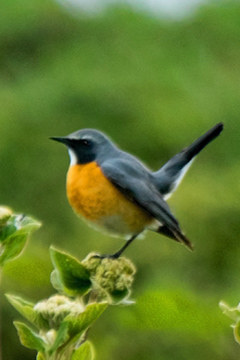
 We had a further look in the area of our hotel, but saw nothing new. Redstarts were around the rooms as we left, but a nice "sting in the tail" was
another Black woodpecker flying over. We now had one area left to visit, this being the famous Mount Aragats. Many people visit there first, it being only
about 60K north of Yerevan, but it doesn't really make much difference. Two birds of great interest to most visiting birders occur there in some numbers, and
although we had had brief views of both Radde's Accentor and White-throated Robin we both wanted more. However, before leaving we returned to the area where
we had seen the Middle-spotted Woodpecker, and whilst Mike continued searching in vain hopes of better views of flycatchers, I "staked out" the tree where
we had parked. In due course the 'pecker appeared, and I was able to get a few shots before it went to the rear of the tree and eventually flew off.
Having seen all the woodland species we wanted, albeit not always terribly well, we made our way to our next hotel, which was at the foot of Mount Aragats,
and arrived there at lunch time. It was advertised as a bed and breakfast, but all we could see was a small food store. However, there was a gate at the side,
so I went in and rang on the door which was up a flight of stairs. A very friendly chap appeared and asked if we were "the booking". I said yes, called Mike
and we followed him upstairs. A large table was spread with all kinds of food, and before we knew it we were invited to sit with the family for lunch. Although
we initially declined, it was obvious we were being made very welcome, so we enjoyed a really good lunch with plenty of variety, and ample vodka. I actually
didn't have any vodka, but Mike apparently,is a bit of a connoisseur and he pronounced it excellent.We still had plenty of time for a drive up the
mountain, so we drove up to a high plateau, only stopping once on the way for brief views of White-throated Robin. At the plateau we found a number of birds
flying around, obviously feeding on areas uncovered by snow. The road continued to a number of buildings at the top, we resolved to go the whole way the
following day, but as it was surrounded by deep snow on both sides we thought there may well be vehicles coming down mid-afternoon, and there were few places
to pass. We had plenty to keep us occupied, as most of the birds were very flighty. Eventually it appeared that the largest numbers were Twite, but looking very
different to "our" Twite, being paler with more white in the plumage. A split is unlikely, but they were worth seeing nonetheless. A flock of White-winged Snowfinches
were around briefly, but the identity of two Crimson-winged Finches had to be confirmed the next day as they were somewhat distant. Perhaps the biggest surprises
were numbers of Skylark and Woodlark, not species you expect to photograph on snow!Having ticked walking on the snow we decided to return down the mountain,
but took a detour to view the main reason most people visit, the monastery perched on a seemingly inaccesible crag. This was at the end of a fork in the road which
was about three miles long, and has breeding Lammergeier, although we only saw a distant bird soaring. Few other birds were seen, but we didn't stop as we wanted
to get back by nightfall. This turned out to be a good idea, since there was a huge thunderstorm that evening.
We had a further look in the area of our hotel, but saw nothing new. Redstarts were around the rooms as we left, but a nice "sting in the tail" was
another Black woodpecker flying over. We now had one area left to visit, this being the famous Mount Aragats. Many people visit there first, it being only
about 60K north of Yerevan, but it doesn't really make much difference. Two birds of great interest to most visiting birders occur there in some numbers, and
although we had had brief views of both Radde's Accentor and White-throated Robin we both wanted more. However, before leaving we returned to the area where
we had seen the Middle-spotted Woodpecker, and whilst Mike continued searching in vain hopes of better views of flycatchers, I "staked out" the tree where
we had parked. In due course the 'pecker appeared, and I was able to get a few shots before it went to the rear of the tree and eventually flew off.
Having seen all the woodland species we wanted, albeit not always terribly well, we made our way to our next hotel, which was at the foot of Mount Aragats,
and arrived there at lunch time. It was advertised as a bed and breakfast, but all we could see was a small food store. However, there was a gate at the side,
so I went in and rang on the door which was up a flight of stairs. A very friendly chap appeared and asked if we were "the booking". I said yes, called Mike
and we followed him upstairs. A large table was spread with all kinds of food, and before we knew it we were invited to sit with the family for lunch. Although
we initially declined, it was obvious we were being made very welcome, so we enjoyed a really good lunch with plenty of variety, and ample vodka. I actually
didn't have any vodka, but Mike apparently,is a bit of a connoisseur and he pronounced it excellent.We still had plenty of time for a drive up the
mountain, so we drove up to a high plateau, only stopping once on the way for brief views of White-throated Robin. At the plateau we found a number of birds
flying around, obviously feeding on areas uncovered by snow. The road continued to a number of buildings at the top, we resolved to go the whole way the
following day, but as it was surrounded by deep snow on both sides we thought there may well be vehicles coming down mid-afternoon, and there were few places
to pass. We had plenty to keep us occupied, as most of the birds were very flighty. Eventually it appeared that the largest numbers were Twite, but looking very
different to "our" Twite, being paler with more white in the plumage. A split is unlikely, but they were worth seeing nonetheless. A flock of White-winged Snowfinches
were around briefly, but the identity of two Crimson-winged Finches had to be confirmed the next day as they were somewhat distant. Perhaps the biggest surprises
were numbers of Skylark and Woodlark, not species you expect to photograph on snow!Having ticked walking on the snow we decided to return down the mountain,
but took a detour to view the main reason most people visit, the monastery perched on a seemingly inaccesible crag. This was at the end of a fork in the road which
was about three miles long, and has breeding Lammergeier, although we only saw a distant bird soaring. Few other birds were seen, but we didn't stop as we wanted
to get back by nightfall. This turned out to be a good idea, since there was a huge thunderstorm that evening.
|











